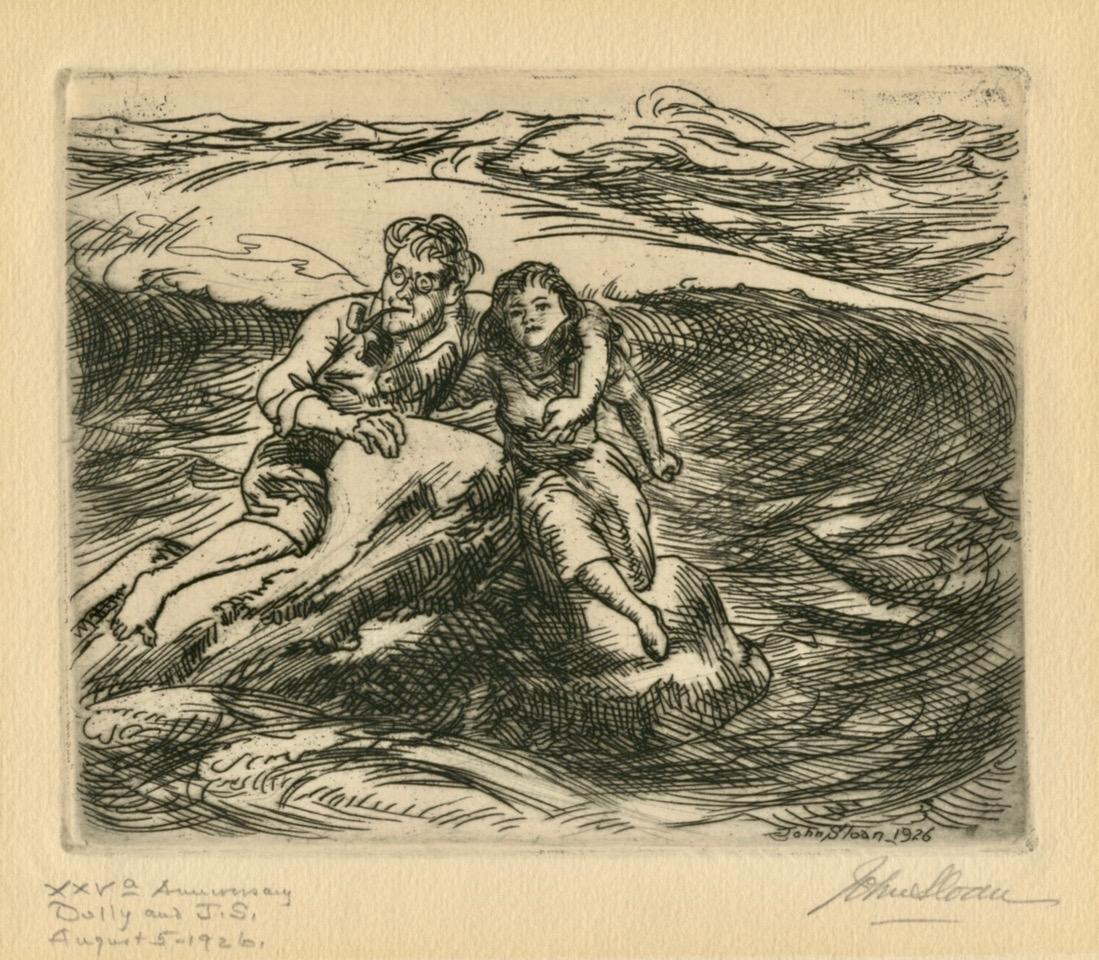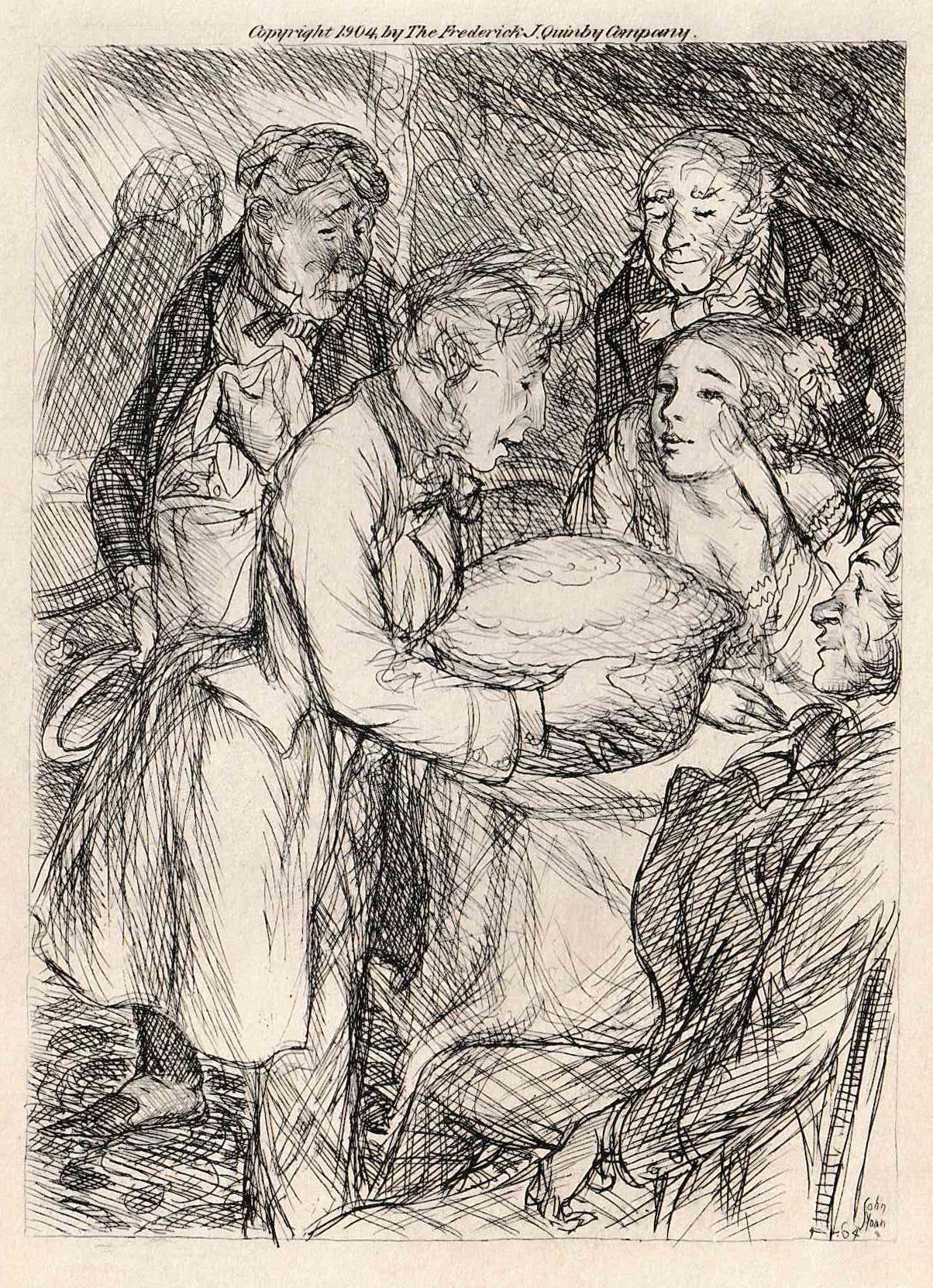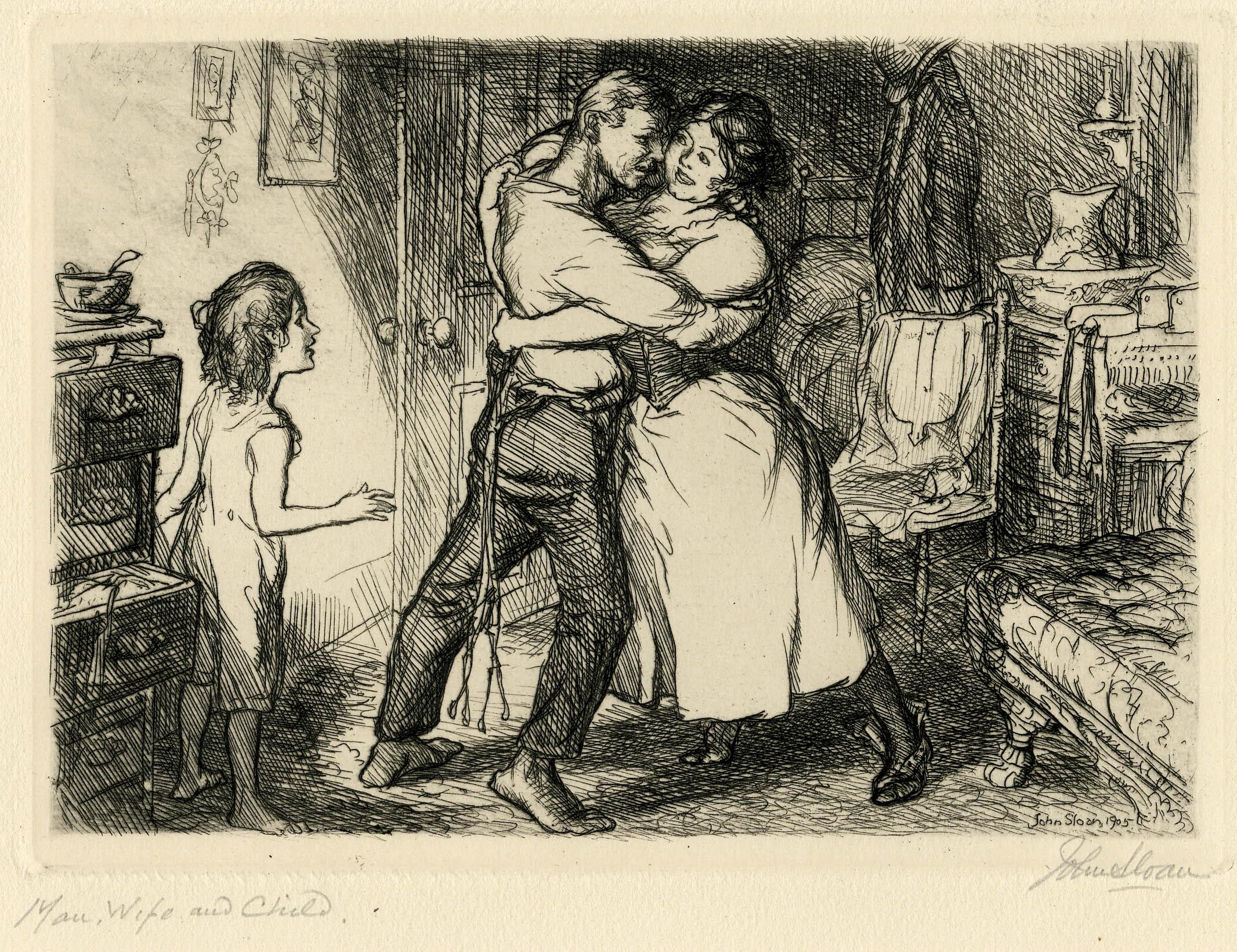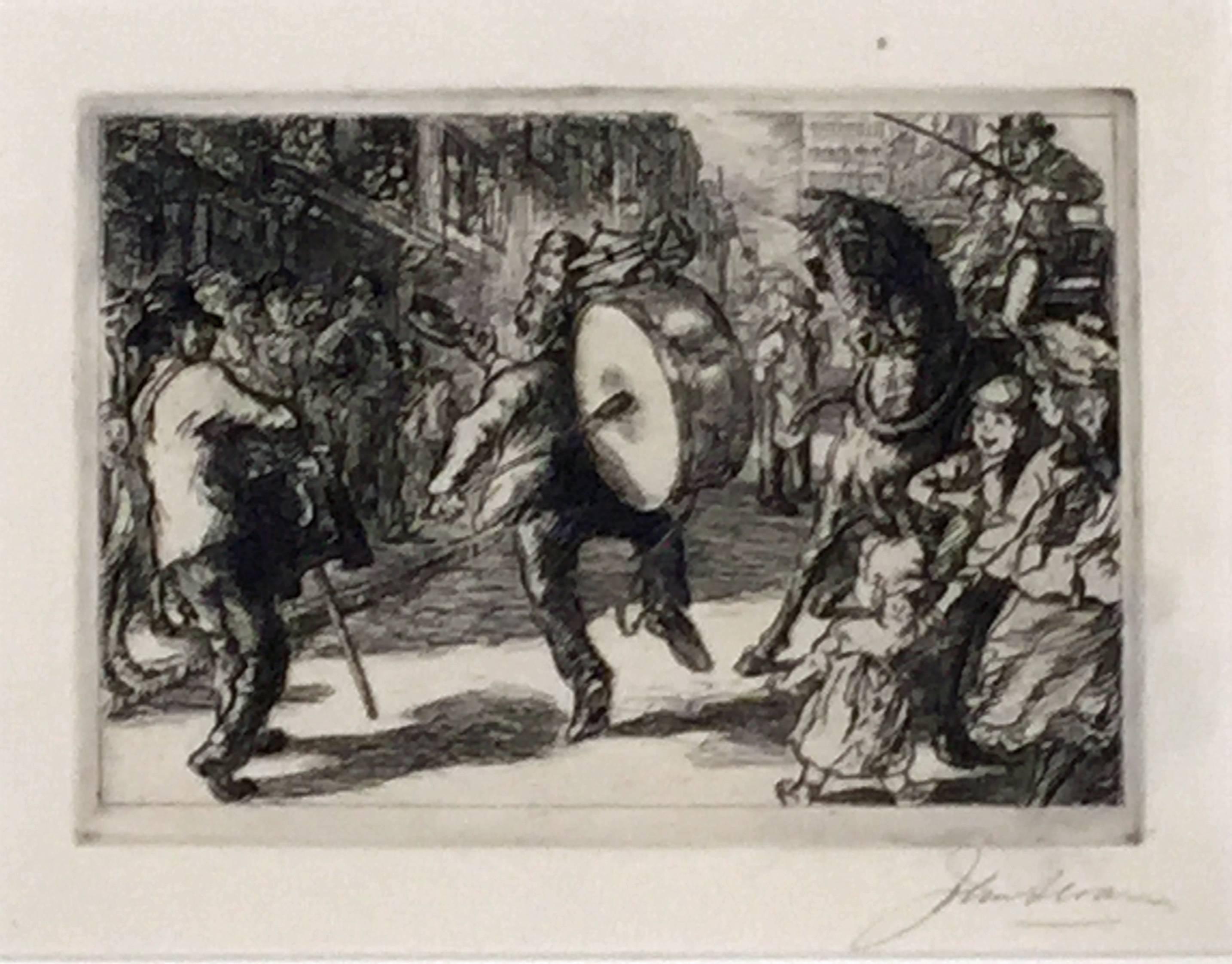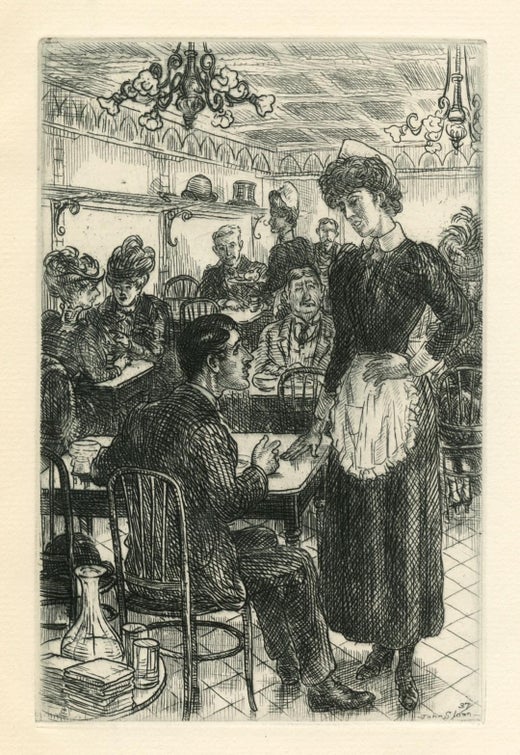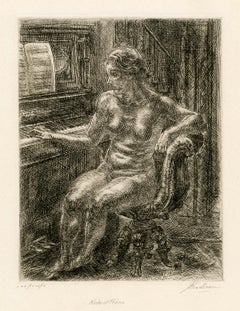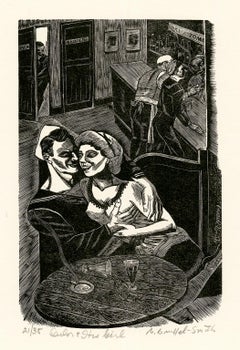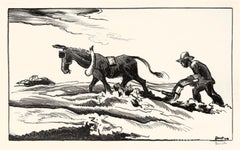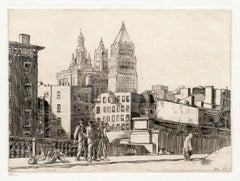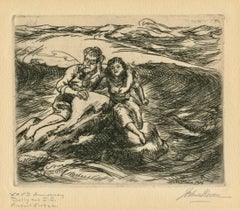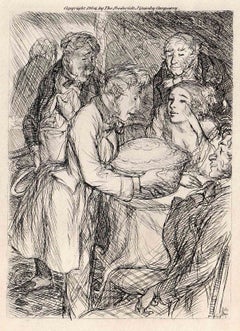Want more images or videos?
Request additional images or videos from the seller
1 of 3
John SloanNew Year’s Eve and Adam1918
1918
$1,100
£837.65
€956.54
CA$1,545.64
A$1,695.86
CHF 893.30
MX$20,174.01
NOK 11,443.01
SEK 10,449.03
DKK 7,146.29
About the Item
John Sloan, 'New Year's Eve and Adam', etching, 1918, edition 100, (only 85 printed), Morse 190. Signed, titled and annotated '100 proofs' in pencil. Signed and dated in the plate, lower left. A superb impression, on antique, cream laid paper, with full margins (1 5/8 to 2 3/8 inches), in excellent condition. Printed by Ernest Roth. Matted to museum standards, unframed.
Sloan used this print as a greeting for New Year’s 1919. "With some exaggeration, this records an incident of the holiday season in a New York Hotel, the Brevoort –J.S."
Impressions of this work are in the collections of the following musuem collections: Library of Congress, Metropolitan Museum of Art, Philadelphia Museum of Art.
ABOUT THE ARTIST
Dubbed the “dean of American artists,” John Sloan was one of the most influential members of the Ashcan School. Born in 1871 in Lock Haven, PA, he lived and worked in Philadelphia for most of his early career. Self-taught in etching, he enrolled at the Pennsylvania Academy of Fine Arts between 1892-1894, where he studied under Thomas Anshutz. Sloan began his career in commercial illustration in 1892 working for the Philadelphia Inquirer; later moving to the art department at the Philadelphia Press. A member of the ‘Philadelphia Five’, he frequently met with William Glackens, George Luks, Everett Shinn, and Robert Henri at Henri's studio. Henri had a profound influence on Sloan and encouraged him to pursue a fine art career.
Sloan moved to New York City in 1904, then the nation’s cultural and intellectual center and the home of a flourishing art scene. He quickly came to love New York and described it as the “gayest of cities, the cosmopolitan palette where the spectrum changed in every side of the street.” Sloan’s subjects, as diverse and varied as the city itself, celebrated the lives of ordinary Americans in a way that was unprecedented in American art. He painted and etched New York’s great avenues and landmarks, the tenements of the Lower East Side, the sweeping vistas of the Manhattan skyline, the crowd of working-class men at McSorley’s Bar, the audience in the moving picture house, the election night festivities in Herald Square, and the trio of women drying their hair on a Sunday morning. Sloan’s images of New York provided a sprawling and comprehensive pictorial testament to urban life and culture. His student, Guy Péne du Bois aptly described him as the “historian of Sixth Avenue, Fourteenth Street, Union Square, and Madison Square.” Sloan was keenly aware of New York’s rapidly changing environment and acknowledged that “the fun of being a New York painter is that landmarks are torn down so rapidly that your canvases become historical records before the paint on them is dry.”
Sloan’s works are particularly distinctive in the Ashcan genre due to his strong political commitments. In 1910, he joined the Socialist Party and in 1912 began creating illustrations for the popular socialist magazine ‘The Masses’. In spite of great economic prosperity, New York also presented the Ashcan artists with glaring inequalities between the classes. The city itself was physically divided by neighborhoods of grand mansions juxtaposed to poor immigrant communities and dilapidated slums. Sloan was undoubtedly influenced by the socially conscious art of the Mexican muralists Diego Rivera, David Alfaro Siqueiros, and José Clemente Orozco. Though he never espoused propaganda, his socialist beliefs resonate in his urban scenes and deeply sympathetic treatment of lower-class subjects.
An esteemed art instructor, Sloan had a profound influence on his students. Beginning in 1914, he taught at the Art Students League and later at the George Luks School of Art. After his death, the art critic Edward Allan Jewel wrote: “He is the artist’s guide, philosopher and friend. He is himself the artist through and through. And he brings to the profession of teaching a fervor so intense that it may be described as mystical. There are, to be sure, many liberal and independent minds. There are many artists, many teachers. There is only one John Sloan.”
John Sloan left a lasting mark on 20th-century American art and an important legacy for succeeding generations of American artists. After his death, Life Magazine asserted that no living man had a greater influence in the American Art world. His works memorialize a vibrant era of New York’s history and continue to be collected by every major museum including, Metropolitan Museum of Art, Whitney Museum of American Art, Brooklyn Museum, National Gallery of Art, Smithsonian Museum of American Art.
- Creator:John Sloan (1832-1932, American)
- Creation Year:1918
- Dimensions:Height: 3.75 in (9.53 cm)Width: 2.75 in (6.99 cm)Depth: 0.01 in (0.26 mm)
- Medium:
- Movement & Style:
- Period:
- Condition:
- Gallery Location:Myrtle Beach, SC
- Reference Number:Seller: 1021461stDibs: LU53234383282
John Sloan
John Sloancame to New York in 1904 and worked for some time as a freelance illustrator. With Robert Henri, he organized an exhibition of a group of urban realist painters, known as "The Eight" or the "Ashcan School," who challenged traditional notions of art. Having moved to the Village in 1912, Sloan lived with his wife Dolly at 240 West 4th Street and at 88 Washington Place.
About the Seller
5.0
Recognized Seller
These prestigious sellers are industry leaders and represent the highest echelon for item quality and design.
Platinum Seller
Premium sellers with a 4.7+ rating and 24-hour response times
Established in 1995
1stDibs seller since 2016
334 sales on 1stDibs
Typical response time: 1 hour
Associations
International Fine Print Dealers Association
- ShippingRetrieving quote...Shipping from: Myrtle Beach, SC
- Return Policy
More From This Seller
View AllNude at Piano
By John Sloan
Located in Myrtle Beach, SC
John Sloan, 'Nude at Piano', 1933, etching, edition 100, (only 85 printed), Morse 265. Signed, titled and annotated '100 proofs' in pencil. Signed and dated in the plate, lower right...
Category
1930s Ashcan School Nude Prints
Materials
Etching
'Sailor and His Girl' —Mid-Century Modernism, WWII
By Bernard Brussel-Smith
Located in Myrtle Beach, SC
Bernard Brussel-Smith, 'Sailor and His Girl', wood engraving, 1941, edition 35. Signed, titled, and numbered '21/35' in pencil. Signed in the block, lower right. A superb, richly-in...
Category
1940s American Modern Figurative Prints
Materials
Woodcut
'Plowing It Under' — WPA Era American Regionalism
By Thomas Hart Benton
Located in Myrtle Beach, SC
Thomas Hart Benton, 'Goin' Home', lithograph, 1937, edition 250, Fath 14. Signed in pencil. Signed in the stone, lower right. A fine, richly-inked impression, on off-white, wove pape...
Category
1930s American Realist Figurative Prints
Materials
Lithograph
'A Morning in May' — Ashcan School Social Realism, New York City
By Reginald Marsh
Located in Myrtle Beach, SC
Reginald Marsh, 'A Morning in May', etching, 1936, edition 100 (Whitney, 1969), Sasowsky 169. Unsigned as published; numbered '89/100' in pencil. A superb, richly-inked impression, ...
Category
1930s Ashcan School Figurative Prints
Materials
Etching
'Hurdy Gurdy Ballet' — New York City American Scene, Ashcan School
By Glenn O. Coleman
Located in Myrtle Beach, SC
Glenn O. Coleman, 'Hurdy Gurdy Ballet', lithograph 1928, edition 50. Signed, dated, and numbered '14/50' in pencil. Titled in the bottom left margin, in an...
Category
1920s Ashcan School Figurative Prints
Materials
Lithograph
$3,840 Sale Price
20% Off
'The Sixth Avenue Spur, New York City '— American Expressionism
By Frederick K. Detwiller
Located in Myrtle Beach, SC
Frederick K. Detwiller, 'The Sixth Avenue Spur, New York City', lithograph, 1924, edition 20. Signed, dated, titled, and annotated 'Lith 20' in pencil. Inscribed 'To my Friend Herbert L. Jones' in pencil. Signed and dated, in the stone, lower right; initialed and dated '1927' in the stone, lower left. A fine, richly-inked impression, on cream wove paper, with margins (7/8 to 1 1/4 inches); slight toning in the top left sheet edge, otherwise in good condition. Scarce.
Image size 20 1/2 x 14 inches (521 x 356 mm); sheet size 22 1/2 x 16 inches (572 x 406 mm). Archivally matted to museum standards, unframed.
ABOUT THE IMAGE
The Sixth Avenue El was constructed in the late 1870s by the Gilbert Elevated Railway and reorganized as the Metropolitan Elevated Railway. By 1878, it was running from Rector Street to 58th Street. Soon after that, it was taken over by the Manhattan Railway Company, with three other Manhattan elevated train lines. The company built a connection, the ‘spur’ by which it turned west on 53rd Street to merge with the 9th Avenue El—paralleling the present-day route of the 6th Avenue subway.
The Sixth Avenue El served the “Ladies Mile” shops (including the Siegel-Cooper emporium, whose building now houses Bed...
Category
1920s Ashcan School Figurative Prints
Materials
Lithograph
You May Also Like
Twenty-Fifth Anniversary; Invitation to a party .....
By John Sloan
Located in Middletown, NY
Invitation to a party on the occasion of John and Dolly Sloan's twenty-fifth wedding anniversary.
Sante Fe: Printed by Peter J. Platt, 1926. 100. Etching on cr...
Category
1920s American Modern Portrait Prints
Materials
Etching
The Silent Pie
By John Sloan
Located in Middletown, NY
Etching on cream wove paper, 5 3/8 x 4 1/4 inches (135 x 107 mm), signed in the plate, lower right. Third state (of 3), from the novel The Flower Girl, vol. 2. by Paul de Kock. In go...
Category
Early 20th Century American Modern Figurative Prints
Materials
Handmade Paper, Etching
The Silent Pie
By John Sloan
Located in Middletown, NY
Boston: Frederick J. Quinby Company, 1904.
Etching on cream wove paper, 5 3/8 x 4 1/4 inches (135 x 107 mm), signed in the plate, lower right. Third state (of 3), from the novel The ...
Category
Early 20th Century American Modern Figurative Prints
Materials
Etching
Man, Wife and Child
By John French Sloan
Located in Fairlawn, OH
Man, Wife and Child
Etching, 1905
Signed and titled in pencil by the artist below image (see photo)
Annotated in pencil by the artist "100 proofs"
Signed and dated in the plate lower...
Category
Early 1900s Ashcan School Figurative Prints
Materials
Etching
MAN MONKEY.
By John Sloan
Located in Portland, ME
Sloan, John. MAN MONKEY. M.130. Etching, 1905. Edition of 100, Signed by Sloan. Dated in the lower margin "June 13 - 1905," and further inscribed "J. S. imp. dated by Sloan - final s...
Category
Early 1900s American Realist Figurative Prints
Materials
Etching
Fashions of the Past
By John Sloan
Located in New York, NY
John Sloan (American 1871 – 1954), Fashions of the Past, etching and aquatint, 1926, signed and titled by the artist in pencil (Morse 224 IV/IV), also signed by the printer. From the...
Category
1920s American Realist Figurative Prints
Materials
Etching, Aquatint
More Ways To Browse
Adam Eve
Dali The Kiss
Dali Tree Of Life
Dali Tree Of Penitence
Dali Trilogy
Dali Turtle
Dali Venus In Furs
Dali Virgil Last Words
Damien Hirst The Dead
David Dawson
David Hockney Blue Guitar
David Hockney Lemon
David L Abel
David Shrigley Black Cats Everywhere
Degas Ballerina Etchings
Degas Signed Lithograph
Dieu Et Mon Droit
Distorted Face Paintings
